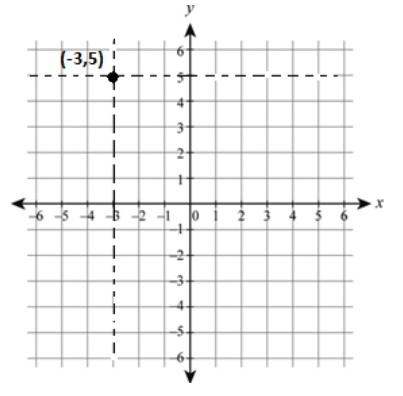
Find the equation of the line(s) passing through the point $\left( { - 3,5} \right)$ among the following options:
(A) $x = - 3$
(B) $y = - 3$
(C) $x = 5$
(D) $y = 5$
Answer
578.4k+ views
Hint:Try making a diagram of the Cartesian plane and mark the point given in the question. Use the concept of the equation of line parallel to x-axis and y-axis. Find out the point of intersection of the lines with x and y-axis to find the correct equations from the given options.
Complete step-by-step answer:

Let’s try to understand the question first. We are given one point $\left( { - 3,5} \right)$ and four options with the equation of the line. The solution is to find the equation that passes through the point$\left( { - 3,5} \right)$.
Since it is well known and reasonable that there can be the infinite number of the line that can pass through a single given point. So, we should try to solve this problem through reasoning.
Draw a rough figure of a Cartesian plane and mark point $\left( { - 3,5} \right)$on it. Look into the figure as we go to further steps.
Firstly, you should understand that the equation of x-axis is $y = 0$ and equation of y-axis is $x = 0$.
Secondly, the equation of any line parallel to the x-axis is $y = a$ for all integers $'a'$ and the equation of any line parallel to y-axis is $x = a$ for all integers$'a'$. Also, a line $y = a$ is parallel to the x-axis and passes to the point $\left( {0,a} \right)$ at the y-axis. Similarly, a line $x = a$ is parallel to the y-axis and passes to the point $\left( {a,0} \right)$ at x-axis.
Therefore, for any point $\left( { - 3,5} \right)$, if a line passing to it and is parallel to the x-axis, will always pass the y-axis at the point $\left( {0,5} \right)$. And any line passing to $\left( { - 3,5} \right)$ is parallel to the y-axis, and will always pass the x-axis at a point $\left( { - 3,0} \right)$.
Thus, the equation for such lines will be $y = 5$ and $x = - 3$. Any other line parallel to either x-axis or y-axis will never pass through the point $\left( { - 3,5} \right)$.
So, the correct answer is “Option A and D”.
Note:Make a rough diagram while solving such problems to make it more understandable. You can also check for the rest of the options given in the question. The Option (B) $y = - 3$ will pass through $(0, - 3)$ parallel to x-axis and Option (C) $x = 5$ will pass through $\left( {5,0} \right)$ parallel to the y-axis.
Complete step-by-step answer:

Let’s try to understand the question first. We are given one point $\left( { - 3,5} \right)$ and four options with the equation of the line. The solution is to find the equation that passes through the point$\left( { - 3,5} \right)$.
Since it is well known and reasonable that there can be the infinite number of the line that can pass through a single given point. So, we should try to solve this problem through reasoning.
Draw a rough figure of a Cartesian plane and mark point $\left( { - 3,5} \right)$on it. Look into the figure as we go to further steps.
Firstly, you should understand that the equation of x-axis is $y = 0$ and equation of y-axis is $x = 0$.
Secondly, the equation of any line parallel to the x-axis is $y = a$ for all integers $'a'$ and the equation of any line parallel to y-axis is $x = a$ for all integers$'a'$. Also, a line $y = a$ is parallel to the x-axis and passes to the point $\left( {0,a} \right)$ at the y-axis. Similarly, a line $x = a$ is parallel to the y-axis and passes to the point $\left( {a,0} \right)$ at x-axis.
Therefore, for any point $\left( { - 3,5} \right)$, if a line passing to it and is parallel to the x-axis, will always pass the y-axis at the point $\left( {0,5} \right)$. And any line passing to $\left( { - 3,5} \right)$ is parallel to the y-axis, and will always pass the x-axis at a point $\left( { - 3,0} \right)$.
Thus, the equation for such lines will be $y = 5$ and $x = - 3$. Any other line parallel to either x-axis or y-axis will never pass through the point $\left( { - 3,5} \right)$.
So, the correct answer is “Option A and D”.
Note:Make a rough diagram while solving such problems to make it more understandable. You can also check for the rest of the options given in the question. The Option (B) $y = - 3$ will pass through $(0, - 3)$ parallel to x-axis and Option (C) $x = 5$ will pass through $\left( {5,0} \right)$ parallel to the y-axis.
Recently Updated Pages
Master Class 8 Maths: Engaging Questions & Answers for Success

Class 8 Question and Answer - Your Ultimate Solutions Guide

Master Class 7 Maths: Engaging Questions & Answers for Success

Class 7 Question and Answer - Your Ultimate Solutions Guide

Master Class 6 Maths: Engaging Questions & Answers for Success

Class 6 Question and Answer - Your Ultimate Solutions Guide

Trending doubts
What is meant by exothermic and endothermic reactions class 11 chemistry CBSE

Which animal has three hearts class 11 biology CBSE

10 examples of friction in our daily life

One Metric ton is equal to kg A 10000 B 1000 C 100 class 11 physics CBSE

1 Quintal is equal to a 110 kg b 10 kg c 100kg d 1000 class 11 physics CBSE

Difference Between Prokaryotic Cells and Eukaryotic Cells




